#2 - After The Gold Rush: A Perspective on Future U.S. Natural Gas Supply and Price
Posted by aeberman on January 1, 2013 - 12:33pm
The Oil Drum staff wishes a Happy New Year to all in our readership community. We are on a brief hiatus during this period, and will be back with our regular publications early in the new year. In the meantime, we present the top ten of best read Oil Drum posts in 2012. The ninth in this series is a post by Arthur Berman on the cost of shale gas production and its relation to the US natural gas price, originally published in February 2012.
U.S. Shale Plays
The advent of shale plays provided an important new source of gas. Yet this new supply is characterized by high decline rates which means that wells must be continuously drilled to maintain supply. In 2001, the U.S. natural gas decline rate was about 23% and the annual replacement requirement was 12 Bcf/d when total consumption was 54 Bcf/d. Today, the decline rate is estimated to be 32% and increased consumption of gas means that approximately 22 Bcf/d must be replaced each year (Exhibits 1 and 2).
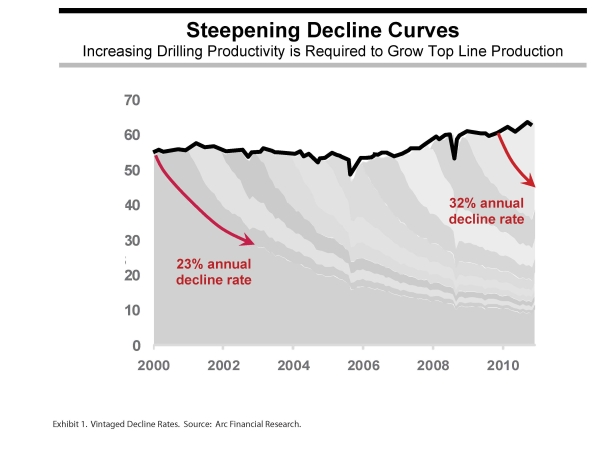
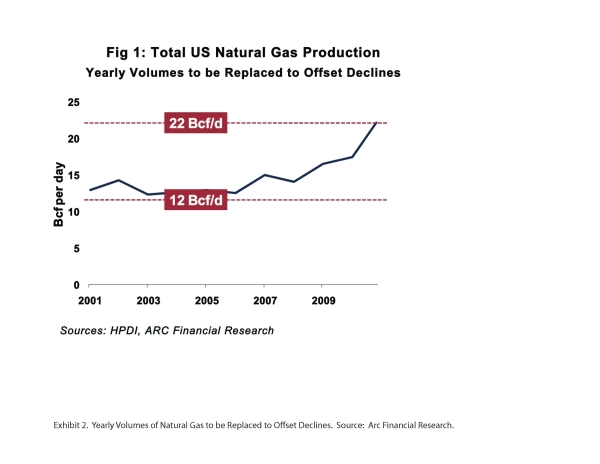
According to ARC Financial Research, $22 billion per quarter is needed to maintain domestic gas supply based on analysis of the 34 top U.S. publicly traded producers. Cash flow for those companies is $12 billion per quarter so there is a $10 billion quarterly cash flow deficit (Exhibit 3). The important factor here is that on a whole there are no retained earnings, and historically growth stems from retained earnings. Without retained earnings, companies must borrow money or sell assets into joint venture agreements to raise cash in order to drill.
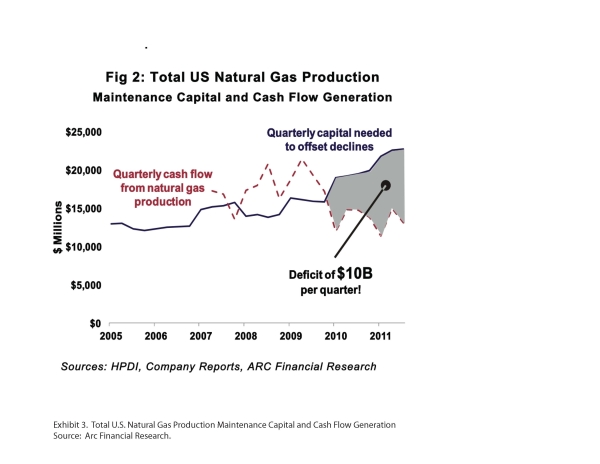
While the continued drilling has been funded by debt, share offerings and joint venture agreements thus far, the trend is unsustainable given the steep decline in prices, despite some favorable hedges. Drilling, therefore, must decrease in order to shrink the present over-supply and so that prices can rise.
U.S. shale plays share many characteristics with the gold rushes of the nineteenth and early twentieth centuries. Both phenomena result from extreme promotion. Anyone can join. Every participant believes that they will get rich. Great amounts of capital are destroyed as entrants try to get a position. The bonanza is exhausted sooner than most expected (Andreoli, 2011) and few profit in the end except for the vendors that serve participants.
For several years, we have been asked to believe that less is more, that more oil and gas can be produced from shale than was produced from better reservoirs over the past century. We have been told more recently that the U.S. has enough natural gas to last for 100 years. We have been presented with an improbable business model that has no barriers to entry except access to capital, that provides a source of cheap and abundant gas, and that somehow also allows for great profit. Despite three decades of experience with tight sandstone and coal-bed methane production that yielded low-margin returns and less supply than originally advertised, we are expected to believe that poorer-quality shale reservoirs will somehow provide superior returns and make the U.S. energy independent. Shale gas advocates point to the large volumes of produced gas and the participation of major oil companies in the plays as indications of success. But advocates rarely address details about profitability and they never mention failed wells.
Shale gas plays are an important and permanent part of our energy future. We need the gas because there are fewer remaining plays in the U.S. that have the potential to meet demand. A careful review of the facts, however, casts doubt on the extent to which shale plays can meet supply expectations except at much higher prices.
One Hundred Years of Natural Gas
The U.S. does not have 100 years of natural gas supply. There is a difference between resources and reserves that many outside the energy industry fail to grasp. A resource refers to the gas or oil in-place that can be produced, while a reserve must be commercially producible. The Potential Gas Committee (PGC) is the standard for resource assessments because of the objectivity and credentials of its members, and its long and reliable history. In its biennial report released in April 2011, three categories of technically recoverable resources are identified: probable, possible and speculative.
The President and many others have taken the PGC total of all three categories (2,170 trillion cubic feet (Tcf) of gas) and divided by 2010 annual consumption of 24 Tcf. This results in 90 and not 100 years of gas. Much of this total resource is in accumulations too small to be produced at any price, is inaccessible to drilling, or is too deep to recover economically.
More relevant is the Committee’s probable mean resources value of 550 (Tcf) of gas (Exhibit 4).
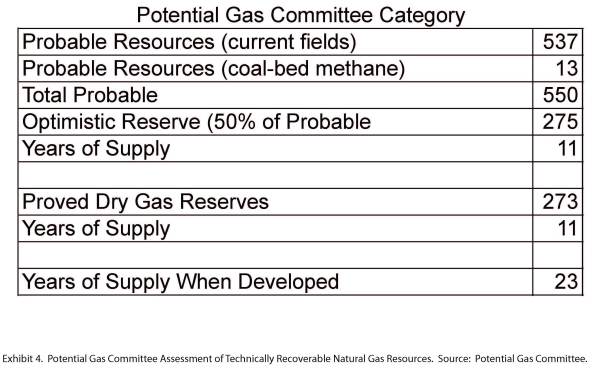
If half of this supply becomes a reserve (225 Tcf), the U.S. has approximately 11.5 years of potential future gas supply at present consumption rates. When proved reserves of 273 Tcf are included, there is an additional 11.5 years of supply for a total of almost 23 years. It is worth noting that proved reserves include proved undeveloped reserves which may or may not be produced depending on economics, so even 23 years of supply is tenuous. If consumption increases, this supply will be exhausted in less than 23 years. Revisions to this estimate will be made and there probably is more than 23 years but based on current information, 100 years of gas is not justified.
Shale Gas Plays May Not Provide Sustainable Supply
Several of the more mature shale gas plays are either in decline or appear to be approaching peak production. Exhibit 5 shows that total Barnett Shale production is approximately 5.7 Bcf per day (Bcf/d) and cumulative gas production is more than 10 trillion cubic feet (Tcf) of gas. It also shows that production may be approaching a peak at current gas prices despite the constant addition of new wells.
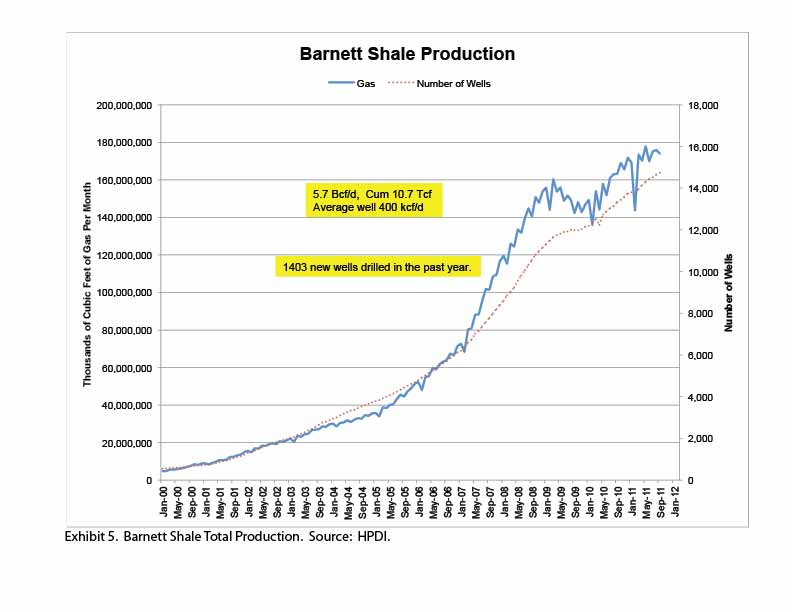
The Haynesville Shale surpassed the Barnett during 2011 as the most productive gas play in North America, with present daily rates of almost 7 Bcf/d and cumulative production of 3.5 Tcf (Exhibit 6).
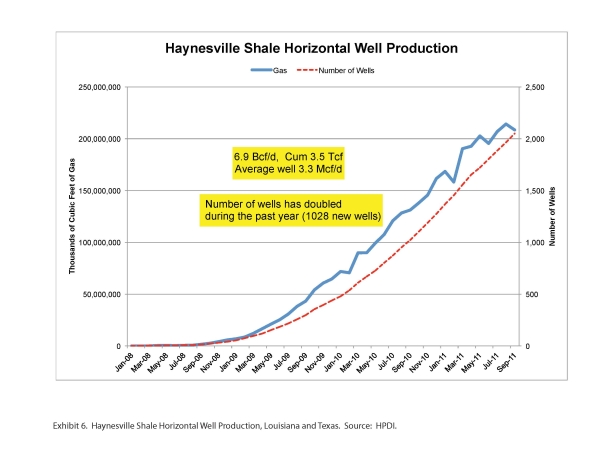
This play is most responsible for the current over-supply of gas with the average well producing 3.3 million cubic feet per day (Mcf/d) compared to only 0.4 Mdf/d in the Barnett. It is too early to say for sure, but the Haynesville Shale may also be approaching peak production.
The Marcellus Shale is presently producing 2.4 Bcf/d and has produced a total of about 0.8 Tcf (Exhibit 7).
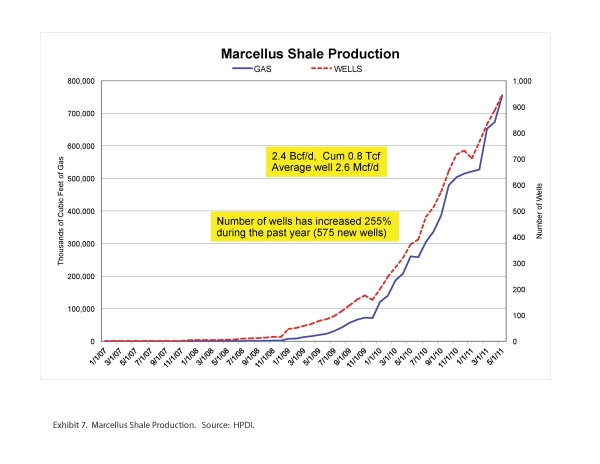
In this play, production shows no sign of leveling off, as it does in the Barnett and Haynesville, and production in the Fayetteville Shale may also be approaching a peak (Exhibit 8).
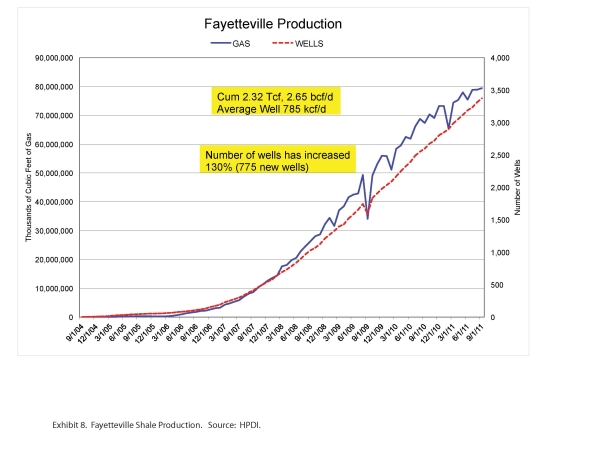
The Woodford Shale is already in decline (Exhibit 9).
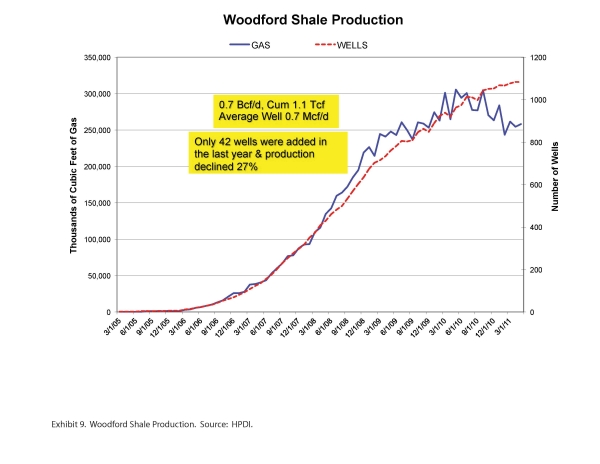
If some existing shale gas plays are approaching peak production after only a few years since the advent of horizontal drilling and multi-stage hydraulic fracturing, what is the basis for long-term projections of abundant gas supply?
What Publicly Available Data Indicates About Supply
Data for this analysis is from publicly available sources provided by government agencies such as the Texas Railroad Commission (TX RRC), the Louisiana Department of Natural Resources (LA DNR), the Oklahoma Corporation Commission, and the Bureau of Ocean Energy Management, Regulation and Enforcement (BOEMRE). This data is available on web sites maintained by these agencies but is also collected and compiled for a fee by service companies, specifically IHS and HPDI (DI Desktop). All of these sources provide access to individual well, field, county, and state production.
The EIA provides valuable data on oil and gas production but not at finer than state level, and state production is only current through 2010. EIA gas production data differs somewhat from state data and from the data collected by service companies, and is generally more optimistic. The EIA uses a model to calculate gas production based on a sample of large gas producers, and then applies a correction to reconcile production with underground storage volumes.
Exhibit 10 shows the discrepancy for Texas gas production between EIA and TX RRC data.
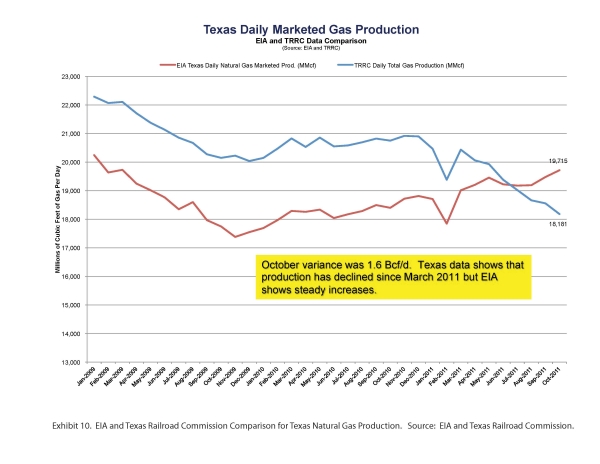
The October 2012 difference was 1.6 Bcf/d. Although TX RRC Data indicates that Texas gas production has declined each month since March 2011, EIA reports show consistent increases. This difference is important because Texas produces 28% of U.S. gas supply (Exhibit 11). Similar differences have been noted for other major gas-producing regions. It should be noted that the EIA data in Exhibit 11 represents marketed production while the TX RRC data shows total gas production.

These accounts should have different values but also should have similar trends. The trends are similar through March 2011 but then diverge producing the present noted variance (The November difference, not shown on the graph, is 2.6 Bcf/d).
We have studied Texas production reporting and find that it is generally reliable and accurate in areas that we follow closely in our oil and gas exploration and production business. Revisions are common for the first and second most recent months of production but are not statistically significant at the state or field level. Data going back three reporting months is reliable. Studies of other major gas-producing states show similar results. Our intent to is to point out the differences between state and EIA data, and to suggest that EIA data is not particularly useful to track individual play or some state production on a current basis.
Texas, Louisiana, Wyoming, Oklahoma, Gulf of Mexico Outer Continental Shelf, and New Mexico account for roughly 75% of U.S. natural gas supply and, therefore, provide a useful proxy for total U.S gas production. Exhibits 12 through 17 show natural gas production for these regions.

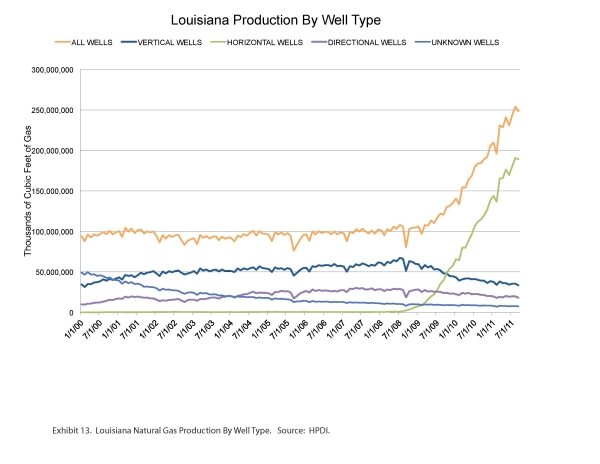
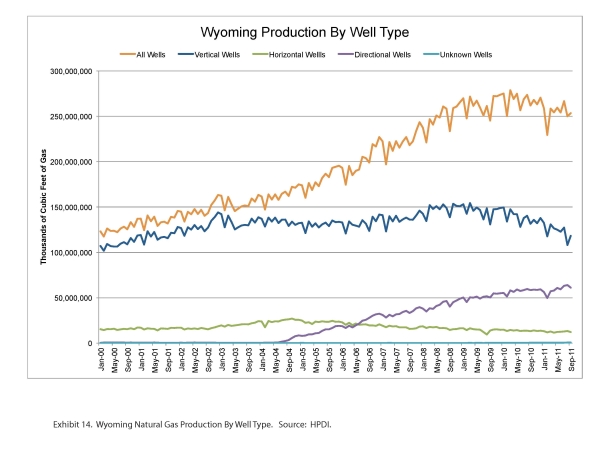
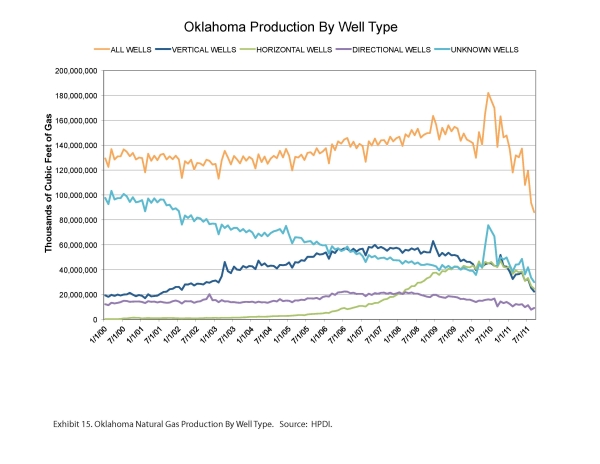
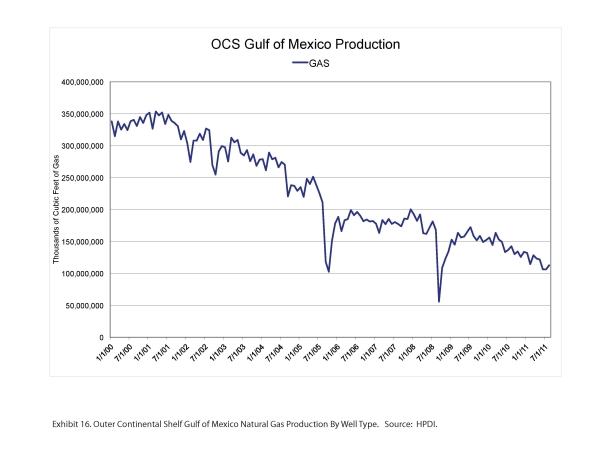

All of these major gas-producing areas except Louisiana are in decline. This is largely because non-shale production is declining rapidly since little new drilling in these reservoirs in recent years has occurred. While shale production volumes and initial rates are impressive (Exhibit 18), much of this new production is merely substituting for depleting conventional gas reserves.
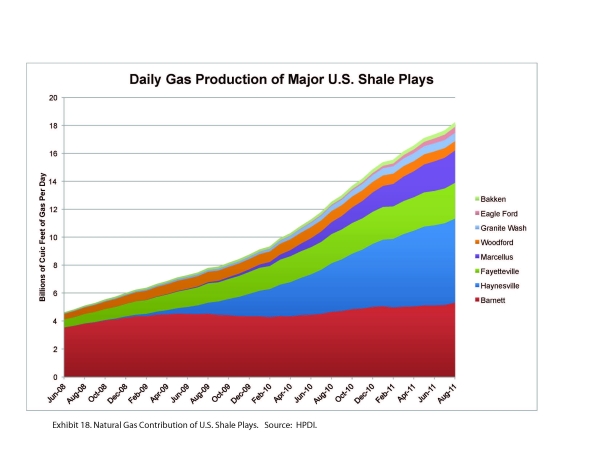
With the shift to more oil-prone or "liquids-rich" shale plays, many observers have suggested that associated gas production from these plays is or will be a major contributor to the present over-supply of gas. Approximately 3% of total U.S. gas supply is from shale associated gas so, while this is a factor, it is not the cause of over-supply. Details of this analysis may be found in an earlier post. Overall, U.S. natural gas production using state-level data appears to have reached an undulating plateau (Exhibit 19).
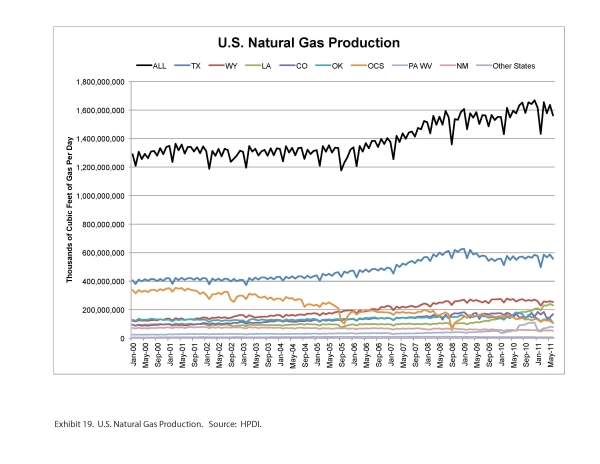
Conclusions
A secular shift has occurred in the U.S. domestic gas supply by drilling mostly shale formations, formerly considered source rocks too costly to develop. The tremendous number of wells drilled in the last several years has contributed to an over-supply of gas. The shale revolution did not begin because producing oil and gas from shale was a good idea but because more attractive opportunities were largely exhausted. Initial production rates from shale are high but expensive drilling and completion costs make economics challenging. The gold rush mentality taken by companies to enter shale plays has added expensive leases and new pipelines to those costs, further complicating shale gas economics.
In the decades before shale plays, the exploration and production emphasis was on discipline. Science was used to identify the most prospective areas in order to limit the amount of acreage to be acquired and its cost. Shale plays have produced a land grab business model in which hundreds of thousands of acres are acquired by each company. Unprecedented lease costs have become the norm often based on limited information and science.
Operators have indulged in over-drilling these plays for many reasons but adding reserves, holding leases and company growth are among the main factors particularly with the low cost of capital. The inevitable result has been the collapse of prices as supply exceeded demand. Most analysts forecast that the future will be much like the present, and that natural gas will be abundant and cheap for decades to come. There are, however, strong and consistent indicators that natural gas supply may be less certain than most observers believe and require a higher price to be developed economically. Natural gas demand is growing as fuel switching for electric power generation continues, and will be increased by environmental regulation in the coming years. The U.S. will shift more of its future energy needs to natural gas in many sectors of the economy. The best justification, in fact, for the land grab and over-drilling spree is expectation of higher prices. Those companies that grabbed the land and held it by production will profit greatly once the true supply and cost of shale gas is recognized.
The financial survival of all companies in this position is not, however, certain. Price matters, and there is finally some response from shale gas producers with recent announcements to curtail drilling. While price was cited as the main reason for reduced drilling, it is likely that some companies now have financial constraints. The shale gas phenomenon has been funded mostly by debt and equity offerings. At this point, further debt and share dilution are less feasible for many companies. Joint ventures have provided a way for some to prolong spending but that now seems like a less likely source of funding. Capital availability in the near term will likely be tighter than is has until now. Acquisition and consolidation may become more attractive to companies with cash as producers become more extended.
Some of the shale gas plays may be at or near peak production at least at the current price of gas and technology. All major producing areas except Louisiana are in decline. Some doubt the accuracy of public data compared with EIA data, but it seems unlikely that the trends it shows are erroneous. In any case, the data the EIA makes available does not have sufficient resolution to evaluate individual plays or state-level trends.
Intermediate-term shale well performance is poorer than assumed previously . Continuous treadmill drilling masks this issue so play decline rates are not recognized. High decline rates are, however, a salient issue meaning that and most of a shale gas well's reserve is produced in the first few years. Well life appears to be shorter than initial expectations. This means that an increasing number of wells must be drilled in order to maintain supply. Now, it appears that fewer wells may be drilled until price recovers to commercial levels. The argument for improved efficiency that cites increasing production with lower rig count is suspect. It is mostly because of the large backlog of previously drilled wells that are just now being connected to sales. This spare capacity provides a boost to supply during a period of falling gas-directed rig count.
The gold rush is over at least for now for the less commercial shale plays. The money and activity have moved to more oil-prone shale plays such as the Eagle Ford and Bakken or to higher potential gas plays such as the Marcellus. Improbable stories that great profits can be made at increasingly lower prices have intersected with reality. A painful adjustment is underway in the natural gas exploration and production industry. Fewer jobs will be created and projects may develop more slowly. This development may expose the notion of long-term natural gas abundance and cheap gas as an illusion. The good news is that this adjustment will lead to higher gas prices in a future less distant than most believe. Higher prices coupled with greater discipline in drilling will allow operators to earn a suitable return and offer the best opportunity for supply to grow to meet future needs.
References
Andreoli, D., 2011, The Bakken Boom - A Modern-Day Gold Rush. The Oil Drum: http://www.theoildrum.com/node/8697.
Berman, A.E. and L. Pittinger, 2011, U.S. Shale Gas: Less Abundance, Higher Cost. The Oil Drum: http://www.theoildrum.com/node/8212.
EIA Annual Energy Outlook 2011 Early Release Overview.
EIA Annual Energy Outlook 2011 Natural Gas Tables: http://www.eia.gov/oiaf/aeo/tablebrowser/#release=EARLY2012&subject=0-EA....
Gilbert, D. and R. Dezember, Chesapeake Energy Pulls Back Amid Natural-Gas Glut: Wall Street Journal, January 24, 2011: http://online.wsj.com/article/SB1000142405297020380650457717865173251197....
Potential Gas Committee 2010 Report: http://www.potentialgas.org/.




This article was originally posted in February 2012; it is now 11 months later, a fair amount of time for the situation to start to play itself out. Has the conclusion above begun to take effect yet? In other words, are small/mid-sized independents (who invested heavily in the land grab, but were selling cheap NG) folding or are they still holding on/able to take on new debt? If not, what sort of time frame is expected for companies holding a lot of debt go under/be acquired by bigger entities?
Also, is the trend of declining production in the major areas still valid? A 1-year update of this post would be informative to see if the conclusions put forth can be validated by recent data/developments.
If I were a natural gas producer, would I produce natural gas at $2, sell it at $4 to make $2 or would I turn that into synthetic gasoline to make $5? I think the market and prices are proven for gasoline.
OK-
Why is it not happening, or am I missing something?
Are our Reptilian Overlords conspiring to stop it?
IMO it is risk and uncertainty. The markets are deregulated which leads to more volatility. It is capital intensive, risk repels capital formation.
A fuel plant producing 1 million gallons of synthetic fuel per day can cost over $1 billion dollars, the Shell Pearl project cost over $20 billion. They are getting the natural gas for FREE in exchange for profits to the host country.
http://www.nytimes.com/2012/12/18/business/energy-environment/sasol-bett...
NYT: A Big, and Risky, Energy Bet
Shell's capital cost for the Qatar project, not counting operating costs, based on the above article are about $135,000 per bpd of synthetic fuel product.
Based on Shell's experience, your example of a million gallons per day, which would be 24,000 bpd, would be a capital cost of about $3.2 billion.
Of course, then there is also the irony of an implied expectation that another finite fossil fuel, natural gas, will save us from the supply problems with different finite fossil fuel, oil.
Hmm, so maybe GTL won't save us after all. And here in Canada they are pushing for lots of LNG terminals to ship it over to Asia. Since even the Canadian Association of Petroleum "Producers" openly admits that the conventional gas deposits in Canada are in decline, this basically leaves only unconventional (ie, expensive) or some miraculous new conventional discovery off the Arctic as our saviour.
Maybe CTL will be a more likely candidate. Again, we're being told N America has centuries of coal left, just as we are with gas. I wonder how accurate that assessment of coal is or if it's just more hot air.
I don't think Shell would have done Pearl if the natural gas were not free for the next 20 years. However, Chesapeake has invested in Sundrop to make synthetic fuels by using natural gas and biomass in a very high temperature process. I assume they have worked the numbers and they come out favorably.
The reason why the is no stampede to build GTL plants is one of cost. They do not make economic sense. Forget the headline price of gas. If you were going to build a multi billion dollar plant you would need to fix the gas cost, and you would not get anything near $2 perMMBTU for a 10 year deal.
My masters have read the Internet and have been sucked in by Shale Gas but even for chemical production, more luctative than fuels, it barely makes sense. We have raked it o er pretty thoroughly and gas to liquid fuels is a looser unless you can get the gas at next to nothing. Gas to olefins is little better and this is confirmed in the lack of any plants outside of China. One group is looking at gas to gasoline but I will bet that the plant will never be built. The only plant that was built was shut down due to low profitability.
Shell and Sasol have both built GTL plants but they are the exception and the output is targeted at higher value chemical applications and lubes where there is more profit to be had. These markets are finite so many more plants will only trash the profitability. I would bet the the Sasol GTL plant planned for North America will end up not being built. The US has now become one of the highest cost areas for construction. It can be built as cheap or cheaper in the ME. GTL by FT is also no use for gamine production. It can produce good jet and diesel but the gasoline is too paraffinic and has a low octane.
I have said it many times on TOD before. GTL is not a viable process for liquid fuels and the total number of plants globally will always be small. Making jet from gas results in a net overall increase in carbon dioxide emissions of about 15% compared with oil derived jet. That is not going to win votes and if the carbon emissions have to be paid for then it will be even less competitive. As for micro GTL I simply do not think it would be profitable. You need scale and running a small scale GTL will push your operating costs through the roof. The problem will be finding the qualified staff to run these plants which is already a problem. Young people do not see the petroleum or chemical industry as sexy. They would rather study for an MBA and then wreck businesses with their crack-pot ideas and PowerPoint us to death working for some consultant who has not got the faintest idea.
That is how shale Gas fever has taken hold and like biofuels it will end in tears.
If I recall discussions some time ago on the Malaysian GTL plant about 40% of the thermal energy of the gas feedstock is used at the plant. If I understand right it's because the Fischer Tropsch process needs partial combustion to generate the required heat and pressure. This forces methane molecules to combine into bigger molecules (eg octane) that will stay liquid at room temperature.
Why not just use straight methane? Storage options include CNG for cars, LNG for semitrailers and adsorption (ANG) for motorbikes. Better still are bifuel vehicles that can use both CNG and petrol, example Opel Zafira. That way if you run out of all fuel on the highway a lawnmower sized canister of unleaded can get you to a CNG pump.
It is wasteful to produce all that heat and CO2 at a GTL refinery and not use it in vehicle miles travelled. I think this will become obvious when liquid fuel prices get out of hand.
Converting 100 million vehicles to CNG is problematic at best. FT has to be done on a large scale to be profitable, hence the $20 billion price tag for Pearl.
Natural gas made into DME and then into synthetic diesel, gasoline and jet fuel can be done on a smaller scale with less capital and lower risk. You still need a natural gas production partner, we may see that in years to come.
Cal - do you know the energy cost of this pathway, compared with FT?
Natural gas to DME to fuel is about 60% efficient. FT is about 50% efficient, but FT creates other products in the process that are used.
I don't go on energy efficiency so much as viability. The U.S. has 200 million vehicles which burn liquid hydrocarbon fuels, that will not change much. To expect a significant percentage of those to be converted to natural gas may not be realistic.
Look at what it costs in energy to turn crude oil into gasoline. Look at what it costs in energy to turn coal or natural gas into electricity. They all have a penalty, but converting 200 million vehicles into EV or NG is not realistic.
Not all GTL has to be big, there are a few companies going into the micro units, with plants of 1000bpd to 15,000bpd being economicial. 9,000cf of gas per barrel and $100,000 Capex for each barrel of production. The main advantage for the modular units is factory production with each unit being able to be shipped by road, rail or barge for quick contruction, and low onsite cost.
The plans for these units are for small stranded gas fields, including FPSOs where currently gas is flared.
http://www.oxfordcatalysts.com/press/ppt/EFI%202012%20Presentation%20121...
Flare gas recovery is a potential growth industry. They can make methanol, companies like CompactGTL makes a product that can be mixed with the extracted oil to be processed at refineries.
Lots of ways we can bring fuel to market without huge capital investments. We will need to combine these with high mileage cars to reduce the amount of imported oil from OPEC countries ASAP.
There is a lot more bang for your buck with high mileage trucks, high horse power diesel, eg drilling rigs, mining trucks and locomotives, as well as bunkering fuel for ships, rather than millions of low use, low mileage personal transport. Though I have been told in Malaysia it is possible to get a professional CNG conversion for 2000 ringat, around $US800.
Due to the marine polution laws that are coming into effect, there seems to be a fair bit of interest in ships using LNG as a bunkering fuel. Cat have also announced that they are "all in" on Nat gas for their high horse power engines.
I will dig up some references when I get some time.
As promised
http://hhpinsight.com/marine/2012/09/caterpillar-embraces-natural-gas/
http://hhpinsight.com/lng/2012/10/marine-lng-will-require-collaboration/
http://hhpinsight.com/epoperations/2012/12/encana-ferus-for-alberta-lng/
http://hhpinsight.com/epoperations/2012/11/ferus-lng-for-frack-engines/
http://hhpinsight.com/epoperations/2012/10/cng-for-ep-in-saskatchewan/
Those frac jobs certainly chew up some fuel! There is a huge amount of oil to be saved in high horsepower engines, with out worrying about converting millions of small users. as they say more bang for their buck.
Now can the Nat Gas producers keep up to their end of the bargain? Time will tell.
Boof - In addition to Calguy's good point there's also that huge problem of a distribution system infrastructure expense. The perpetual chicken and egg problem: no one is going to spend hundreds of $billions expanding the distribution system until many millions on NG fueled cars are purchased. Which won't happen without an expanded distribution system. And then there's the ultimate pricing issue. If we did have a good CNG/LNG distribution system and tens of millions of NG fueled vehicles would what would the price of NG be then? Even though we appear to be flush with NG today would we have the reserves to handle the huge increase in demand? Or would we have to import a huge amount of our motor vehicle fuel as we do now? Today NG is relatively cheap and plentiful because of low demand. Change that dynamic and the economics of NG motor fuel would change significantly IMHO.
We will probably get trucks and buses converted. Any fleet vehicle that goes back to a yard for refueling is a candidate. The economics, cleaner air and less imported oil are all good reasons to convert. We could see delivery trucks and CNG and long haul on LNG, they are working on that right now.
Yet another issue is that price point for gas as a transport fuel is way too high for other gas users. In Australia if truck operators pay $1.40 per litre of liquid diesel with 35 MJ of thermal energy that works out as $40 per GJ. The spot price for piped gas in eastern Australia is around $5 per GJ, expected to strongly increase with the opening of the Gladstone LNG hub in 2015.
Depending on what fuel tax is levied is levied on CNG we can expect non-transport users to pay a lot more for gas as the price is driven up by demand from truckers as a diesel replacement. Maybe the federal govt will legislate that x% of gas production is reserved for non-transport users.
In my opinion transport is a more vital use for gas than say baseload power generation which is the job for nukes.
The transition of large numbers of personal vehicles to CNG usage is presently blocked in a very significant way by regulation and engine certification standards set forth by the DOE and EPA. As an aside, my brother and I did a small business study last year into launching a business which acted chiefly in the conversions market for automobiles to CNG. We decided fairly quickly the reason very few if any non fleet type and government vehicles are presently being modified to use CNG. The costs for licensing and certification are nothing short of astronomical.
Presently there are very serious roadblocks in both cost and regulation in attempting conversions. Our focus was to see if it would be reasonable from a business standpoint to work the infrastructure and conversion angles in order to generate significant demand for CNG usage, thereby causing larger corporations to provide the seed money and lobbying muscle which would be required to CHANGE some of the present regulations which are STEEP barriers to attempting transition on any large scale. These barriers appear to have been put in place by the Oil Co's, the Government, and the EPA, to make it very costly and nearly impossible from a regulatory standpoint for any grass roots effort to succeed.
IMHO after spending several months looking at this issue, until serious efforts at changing the regulations are undertaken, the chance that I, or anyone else on this board can LEGALLY convert their vehicle to CNG use is slim. One of the biggest stumbling blocks is NOT the conversion process itself, it is getting the auto companies to have their engines certified to be converted under existing EPA law. It may take a long while to get this changed, but then even if that happens, undertaking the build out of a distribution and storage system on the scale that is needed becomes very problematic from a capital standpoint.
I file this one under the "Energy Trap" scenario...nothing gets done towards change until there is necessary pain. Once you get there, the economy probably cannot support or provide the money required to move forward with the transition.
Thanks AP. I hadn't heard those high costs. Even though I tend to get a bit uncomfortable with the govt getting too involved in private business it seems some govt pushed effort might be required. But from your post it sounds like they've gone in the opposite direction and appear to be content hindering the effort.
The Federal government is trying to improve the laws concerning NG car conversions. There are safety concerns and if a conversion is done poorly it can pollute more than the gasoline version.
Blaming the government is an excuse, even IF the government said go ahead and do whatever you want, there are barriers to adoption of NG car conversions, we all know what those are. Blaming the federal government for everything was an old Reagan trick, it is just a cop out to ignore the real issues.
I disagree. By far the most dangerous emission would be CO2 - and it would be an almost unimaginably poor conversion that would increase CO2 compared with gasoline or diesel.
The next most dangerous re health may be particulates, gas is known for its extremely low level of particulates - its hard to get a lot of particulates when the gas contains so much less carbon.
It is nonsensical to claim that nitrogen oxides, which may or may not be worse on a given installation, and in fact may be better, outweighs the above.
Then you are disagreeing with the EPA, their position is that a bad CNG conversion CAN pollute more than the original vehicle.
"The tampering prohibition is important because poorly designed modifications can increase emissions."
http://epa.gov/otaq/consumer/fuels/altfuels/altfuels.htm
I am not a bureaucrat. My education was in chemistry, not politics - I can afford to disagree with their position with respect to simple principles of chemistry as it does not put my job on the line for speaking out. Methane contains substantially less carbon per BTU than gasoline or diesel, and substantially more hydrogen. It tends to burn a lot cleaner than heavier hydrocarbons. It produces much less CO2 per BTU than gasoline or diesel because sufficient carbon to produce more CO2 just is not present. Pollution control technology does not reduce the CO2 production of the gasoline or diesel burned - you need to not burn the gas or diesel in the first place.
Truth that is based upon physical principles tends to embarrass because it does not change with policy or one's position, it does not lend itself to spin. Wasn't there a Bush administration official that said something like "we make the truth"? - quite Orwellian - but there will always be a fundamental reality that will constrain what we do as a society -
Its fortunate we live in a democracy and can freely disagree with the EPA or any other part of gov.,- now if we can only get the citizens to think critically, using good data, rather than swallowing statements with little or no factual basis hook line and sinker while ignoring clear sources of bias, we might expect the democracy to work a bit better. Maybe to start, we can think about media reform as much as reform of government? That would help WRT info avail. to the average citizen.
Last time I looked the licensing in the US required a seperate fee for each model of car and for each model year. Something like a $10,000 fee.
I worked a summer job in a garage in Canada in 1981 (!) that was doing these conversions, they were very simple. We were doing a couple per day. Only drawback I saw was the tank that filled up the trunk. I think the conversions cost $1000-$2000. I got to drive the cars over to the fill station.
What we found is that the average conversion cost for material and labor is around 1500-2000 $ for personal vehicles to CNG usage or dual fuel use. The present ACTUAL costs are far higher than that due to EPA/DOE engine certification laws and licensing fees charged to shops who need to train and maintain qualified techs to do the conversions to standards.
The largest issue I see at present, with the way things are right now, is cost. For me to convert, it ranges between 10- 20K at one of a very few shops around that can legally do the work. Costs for individual shops to maintain licenses can be near 100K+/year. Most small shops have no demand for the work, so they cant afford the fees. Thanks to no one BUT the government. The other GIANT issue is engine certification. Unless the auto manufacturer has jumped through the hoops the EPA requires, you cannot do the conversion legally....period. Folks do it presently to be sure, but its at the risk of some very steep fines if found out by the wrong people. The list of engines which are certified is presently VERY SMALL.
Until the laws are changed AND car manufacturers decide to begin certifying ALL engines, this is a complete NON starter IMHO. I most assuredly CAN blame government for the way it is presently.
My guess now is that if some new regulations are passed which allow conversions on a really large scale, you will increase the cost for CNG dramatically once we begin offsetting gasoline usage with this demand. Kind of a catch 22 if you think about it a bit. I believe the cost advantages would still remain, but the large differences we see now between gasoline and CNG will move MUCH closer together at some point.
California Energy Commission to award up to $2.45M for renewable natural gas for transportation fuels
http://www.greencarcongress.com/2013/01/cec-20130105.html
In parts of the world where natural gas in not abundant or too expensive, this could be a way. If you are going to make synthesis gas you might as well go all the way to synthetic fuels.